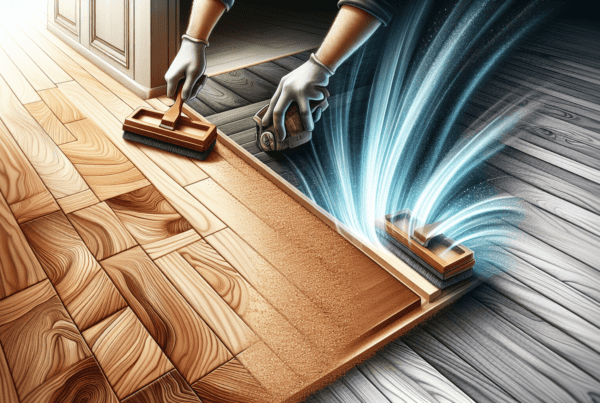In the heart of Wellington, a transformation is taking place underfoot that’s impossible to ignore. The art of timber floor sanding and finishing is bringing a new aura of warmth and refinement to homes and businesses alike, leaving behind a trail of impeccable floors that speak volumes of the craftsmanship involved. With a keen focus on detail and a commitment to perfection, this service is renewing the beauty of wooden floors, making them not only a foundation but a centerpiece of interior aesthetics.
Understanding Timber Floor Sanding & Finishing
The basics of timber floor sanding
We’ve always held the belief that understanding the basics of timber floor sanding is the first step towards achieving a beautiful and long-lasting wood floor. The process begins with the removal of the old finish, scratches, stains, and any other imperfections that have accumulated over time. This is achieved by moving progressively through different grits of sandpaper, starting with a coarser grit to remove the top layers and finishing with a finer grit to smooth the surface. It’s a meticulous job, but doing it right sets the perfect foundation for a stunning finish.
Finishing techniques for a pristine look
Once our floors are smoothly sanded, the next step we look into is the finishing techniques. The choice of finish can greatly affect the look and feel of the timber floors. Whether we’re seeking a glossy, satin, or matte appearance, the application technique matters. Using brushes, rollers, or even a combination of both can give different effects, and sometimes, applying a sealant before the finish can enhance durability and the overall look.
Differences between various types of finishes
Delving into the world of finishes, we find that there’s quite a varied selection to choose from. Polyurethane finishes are popular for their durability and resistance to wear, making them ideal for high-traffic areas. Oil-based finishes, on the other hand, penetrate deeper into the wood, offering a more natural look but requiring more maintenance. Water-based finishes dry faster and have a lower environmental impact, though they might not be as tough. Each type offers distinct advantages and challenges, so our choice typically hinges on the specific needs and conditions of our space.
Benefits of Timber Floor Sanding & Finishing
Enhanced durability of timber floors
By investing in timber floor sanding and finishing, we essentially enhance our floors’ durability. The sanding removes imperfections that could lead to further damage, while the right finish protects the wood from wear, tear, and spills. It’s a dual approach that ensures our floors can withstand the test of time and daily usage.
Improvement in aesthetic appeal
There’s no denying the drastic improvement in aesthetic appeal that comes with properly sanded and finished timber floors. The process brings out the natural beauty of the wood, highlights its grain, and can even make the space look larger and brighter. It’s a transformation that not only appeals to us visually but also adds value to our property.
Maintenance and long-term care reduction
Interestingly, when our timber floors are well-maintained through regular sanding and finishing, we actually reduce the amount of work needed to keep them looking good in the long term. Finished floors are easier to clean, less prone to staining, and require less frequent repairs. This reduction in maintenance not only saves us time but also money.
Choosing the Right Service Provider in Wellington
Factors to consider when selecting a service provider
When we’re on the lookout for a timber floor sanding and finishing service provider in Wellington, there are several factors we consider. Experience and expertise top our list, as they indicate the provider’s ability to handle our specific needs. We also look into the types of equipment and materials they use, preferring those who invest in high-quality, modern tools and eco-friendly finishes.
The importance of reading reviews and testimonials
We’ve found that dedicating some time to reading reviews and testimonials about service providers can be incredibly insightful. These firsthand accounts give us a glimpse into the experiences of past customers, highlighting the provider’s strengths and areas of improvement. Positive feedback reassures us, while any red flags can prompt further questions.
Questions to ask before hiring a service provider
Before we commit to a service provider, we ensure to ask a series of questions to clarify any doubts and set clear expectations. These may include inquiries about their process, the duration of the project, the costs involved, and how they handle unexpected challenges. Clear communication from the start helps in building a good relationship and ensuring a smooth project flow.
The Process of Timber Floor Sanding
Initial assessment and planning
The first step in the sanding process involves an initial assessment of the floor. This is where the provider examines the condition of the timber, identifies any issues that need addressing, and plans the sanding process. This planning stage is crucial for us because it outlines the approach and ensures we’re prepared for the work ahead.
Sanding techniques and equipment used
We take interest in the sanding techniques and equipment our chosen provider uses. Effective sanding typically involves a progression from coarser to finer grits, along with detailed edge and corner work using specialized tools. State-of-the-art sanding equipment that minimizes dust and noise can greatly influence our experience and the outcome.
Handling challenges during sanding
Challenges during sanding, such as deep stains, warps, or extensive damage, require expert handling. We appreciate when providers are upfront about these challenges and communicate their strategies for addressing them. Whether it involves additional treatments or adjusting expectations, knowing these plans in advance helps us feel more confident in the process.
Finishing Touches for Timber Floors
Selecting the right finish for your floor
Selecting the right finish for our timber floors is a decision we don’t take lightly. We consider factors such as the room’s usage, the desired aesthetic, and any maintenance preferences. Consulting with our service provider allows us to choose a finish that not only looks great but also performs well under our specific conditions.
Application techniques for an even coat
The application of the finish needs to be done with precision and care to ensure an even coat. Watching professionals at work, we’ve noted that they often have specific techniques, whether it’s applying thin coats and allowing adequate drying times between them or using particular tools for a smooth finish. This expertise is part of what we pay for, and it significantly impacts the quality of the final result.
Drying and curing times
Understanding drying and curing times for the finish is essential for us to plan our return to normal use of the space. These timelines can vary greatly depending on the type of finish used and the environmental conditions. We ensure to discuss this with our provider, so we have realistic expectations and can make the necessary accommodations.
Post-Finishing Care and Maintenance
Daily maintenance tips
After investing in timber floor sanding and finishing, we’re keen on maintaining the beauty and integrity of our floors. Daily maintenance tips, such as using soft brooms for sweeping, avoiding harsh chemicals, and using protective pads under furniture, become a part of our routine. These small actions go a long way in preserving our floors.
Preventing scratches and damage
Preventing scratches and damage is also a priority for us. We take measures such as placing rugs in high-traffic areas, maintaining pet nails, and immediately cleaning spills to protect our floors. It’s about being proactive rather than reactive to ensure our floors stay in top condition.
When to consider re-sanding and re-finishing
Knowing when to consider re-sanding and re-finishing is crucial for long-term floor care. Signs such as visible wear, discoloration, or damage indicate it might be time for a refresh. We keep an eye on these indicators and plan ahead for maintenance, ensuring our timber floors continue to be a feature we’re proud of.
Cost Considerations
Average costs of timber floor sanding and finishing in Wellington
We understand that cost is a significant consideration for many of us. The average costs of timber floor sanding and finishing in Wellington can vary based on several factors, including the size of the space, the condition of the floors, and the chosen finish. It’s important for us to get detailed quotes from providers to fully understand the financial commitment involved.
How to budget for your project
Budgeting for our timber floor project involves more than just accommodating the initial quote. We also consider potential contingencies for unexpected issues that may arise, the cost of moving and storing furniture, and any accommodation needs during the work. A comprehensive budget ensures we’re not caught off guard financially.
Understanding quotes and avoiding hidden fees
When receiving quotes, we take the time to understand the details and ask about any potential hidden fees. Clarifying what is included in the quote and what might be additional helps us avoid surprises down the line. We also compare quotes from different providers to ensure we’re getting fair value for the service.
The Importance of Sustainable Practices
Eco-friendly sanding and finishing options
In our pursuit of beautiful timber floors, we also consider the impact on the environment. Eco-friendly sanding and finishing options, such as the use of sustainable materials and low-VOC finishes, are important to us. These choices not only contribute to a healthier living space but also align with our values of environmental stewardship.
Choosing sustainable materials and providers
Choosing sustainable materials and providers goes hand in hand with our eco-friendly approach. We look for providers who source their materials responsibly and employ sustainable practices in their operations. This commitment to the environment is something we value and seek out in our partnerships.
Contribution to environmental conservation
Our decisions around timber floor sanding and finishing are not just about aesthetics or durability; they’re also about our contribution to environmental conservation. By opting for sustainable practices and materials, we play our part in reducing our ecological footprint. It’s a choice that benefits us now and contributes to a healthier planet for future generations.
Common Mistakes to Avoid
Skipping the prep work
One of the common mistakes we’ve learned to avoid is skipping the prep work. Proper preparation of the floors and the space is crucial for a successful sanding and finishing project. Ensuring the area is clear, and the floor is ready for sanding helps prevent issues down the line and results in a better finish.
Choosing the wrong type of finish
Choosing the wrong type of finish can have long-term ramifications on our timber floors. A finish that’s too glossy might highlight imperfections, while one that’s too matte might not offer the protection we need. It’s critical to understand the pros and cons of each finish type and select one that suits our floors’ usage and aesthetic preferences.
DIY sanding pitfalls
While the idea of DIY sanding might seem appealing to some of us, it’s fraught with pitfalls. Without the right equipment, experience, and technique, it’s easy to damage the floors, making them worse than before. We’ve come to appreciate the value of professional expertise and the difference it makes to the final outcome.
FAQs on Timber Floor Sanding & Finishing
How long does the process take?
The duration of the timber floor sanding and finishing process can vary greatly depending on the size of the space and the extent of work required. On average, we can expect a project to take anywhere from a few days to over a week. Discussing timelines with our service provider helps us set realistic expectations.
Is it necessary to move out during sanding and finishing?
Whether or not we need to move out during the sanding and finishing process depends on the scope of the project and our personal circumstances. For extensive projects or those involving toxic finishes, it might be advisable. However, with modern equipment and eco-friendly finishes, many of us can stay in our homes, though we might need to vacate specific areas temporarily.
How to deal with gaps and cracks in timber floors?
Gaps and cracks in timber floors can often be addressed as part of the sanding and finishing process. Fillers can be used to close gaps and cracks, ensuring a smooth, even surface ready for finishing. It’s a common issue that professionals are well-equipped to handle, restoring the integrity and appearance of our floors.







